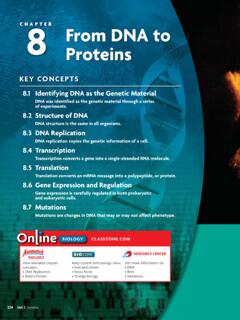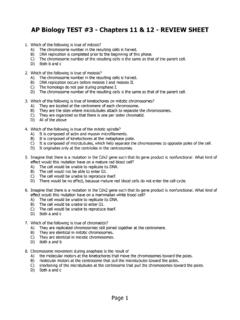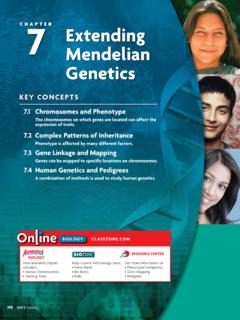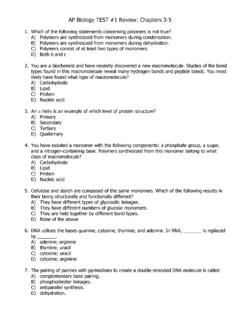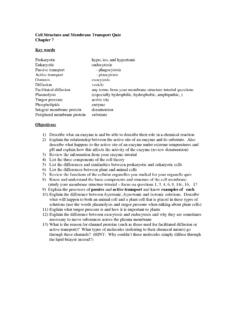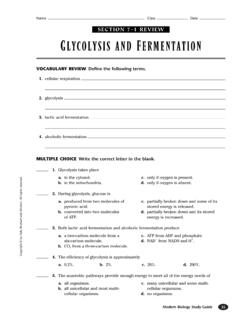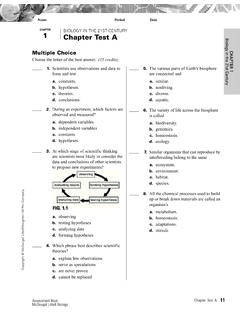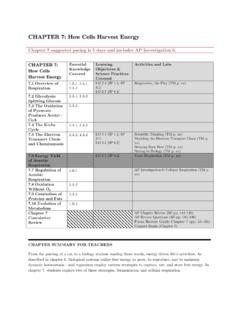Transcription of Campbell's Biology, 9e (Reece et al.) Chapter 9 Cellular ...
1 1 Copyright 2011 Pearson Education, Inc. Campbell's biology , 9e ( reece et al.) Chapter 9 Cellular respiration and fermentation This is one of the most challenging chapters for students to master. Many students become overwhelmed and confused by the complexity of the pathways, with the multitude of intermediate compounds, enzymes, and processes. The vast majority of the questions in this Chapter address central concepts rather than details of these pathways. Other questions have accompanying figures that provide details for reference and ask students to interpret or use these models. Overall, the emphases are on the inputs and outputs of each pathway, the relationships among these pathways, the Cellular locations, redox as a central principle in respiration , and chemiosmosis.
2 Multiple)Choice Questions 1) What is the term for metabolic pathways that release stored energy by breaking down complex molecules? A) anabolic pathways B) catabolic pathways C) fermentation pathways D) thermodynamic pathways E) bioenergetic pathways Answer: B Topic: Concept Skill: Knowledge/Comprehension 2) The molecule that functions as the reducing agent (electron donor) in a redox or oxidation)reduction reaction A) gains electrons and gains potential energy. B) loses electrons and loses potential energy. C) gains electrons and loses potential energy. D) loses electrons and gains potential energy. E) neither gains nor loses electrons, but gains or loses potential energy.
3 Answer: B Topic: Concept Skill: Knowledge/Comprehension 3) When electrons move closer to a more electronegative atom, what happens? A) The more electronegative atom is reduced, and energy is released. B) The more electronegative atom is reduced, and energy is consumed. C) The more electronegative atom is oxidized, and energy is consumed. D) The more electronegative atom is oxidized, and energy is released. E) The more electronegative atom is reduced, and entropy decreases. Answer: A Topic: Concept Skill: Knowledge/Comprehension 2 Copyright 2011 Pearson Education, Inc. 4) Why does the oxidation of organic compounds by molecular oxygen to produce CO2 and water release free energy?
4 A) The covalent bonds in organic molecules and molecular oxygen have more kinetic energy than the covalent bonds in water and carbon dioxide. B) Electrons are being moved from atoms that have a lower affinity for electrons (such as C) to atoms with a higher affinity for electrons (such as O). C) The oxidation of organic compounds can be used to make ATP. D) The electrons have a higher potential energy when associated with water and CO2 than they do in organic compounds. E) The covalent bond in O2 is unstable and easily broken by electrons from organic molecules. Answer: B Topic: Concept Skill: Knowledge/Comprehension 5) Which of the following statements describes the results of this reaction?
5 C6H12O6 + 6 O2 6 CO2 + 6 H2O + Energy A) C6H12O6 is oxidized and O2 is reduced. B) O2 is oxidized and H2O is reduced. C) CO2 is reduced and O2 is oxidized. D) C6H12O6 is reduced and CO2 is oxidized. E) O2 is reduced and CO2 is oxidized. Answer: A Topic: Concept Skill: Knowledge/Comprehension 6) When a glucose molecule loses a hydrogen atom as the result of an oxidation)reduction reaction, the molecule becomes A) hydrolyzed. B) hydrogenated. C) oxidized. D) reduced. E) an oxidizing agent. Answer: C Topic: Concept Skill: Knowledge/Comprehension 7) When a molecule of NAD+ (nicotinamide adenine dinucleotide) gains a hydrogen atom (not a proton), the molecule becomes A) dehydrogenated.
6 B) oxidized. C) reduced. D) redoxed. E) hydrolyzed. Answer: C Topic: Concept Skill: Knowledge/Comprehension 3 Copyright 2011 Pearson Education, Inc. 8) Which of the following statements describes NAD+? A) NAD+ is reduced to NADH during glycolysis, pyruvate oxidation, and the citric acid cycle. B) NAD+ has more chemical energy than NADH. C) NAD+ is oxidized by the action of hydrogenases. D) NAD+ can donate electrons for use in oxidative phosphorylation. E) In the absence of NAD+, glycolysis can still function. Answer: A Topic: Concept Skill: Knowledge/Comprehension 9) Where does glycolysis take place in eukaryotic cells? A) mitochondrial matrix B) mitochondrial outer membrane C) mitochondrial inner membrane D) mitochondrial intermembrane space E) cytosol Answer: E Topic: Concept Skill: Knowledge/Comprehension 10) The ATP made during glycolysis is generated by A) substrate)level phosphorylation.
7 B) electron transport. C) photophosphorylation. D) chemiosmosis. E) oxidation of NADH to NAD+. Answer: A Topic: Concept Skill: Knowledge/Comprehension 11) The oxygen consumed during Cellular respiration is involved directly in which process or event? A) glycolysis B) accepting electrons at the end of the electron transport chain C) the citric acid cycle D) the oxidation of pyruvate to acetyl CoA E) the phosphorylation of ADP to form ATP Answer: B Topic: Concept Skill: Knowledge/Comprehension 12) Which process in eukaryotic cells will proceed normally whether oxygen (O2) is present or absent? A) electron transport B) glycolysis C) the citric acid cycle D) oxidative phosphorylation E) chemiosmosis Answer: B Topic: Concept Skill: Knowledge/Comprehension 4 Copyright 2011 Pearson Education, Inc.
8 13) An electron loses potential energy when it A) shifts to a less electronegative atom. B) shifts to a more electronegative atom. C) increases its kinetic energy. D) increases its activity as an oxidizing agent. E) moves further away from the nucleus of the atom. Answer: B Topic: Concept Skill: Knowledge/Comprehension 14) Why are carbohydrates and fats considered high energy foods? A) They have a lot of oxygen atoms. B) They have no nitrogen in their makeup. C) They can have very long carbon skeletons. D) They have a lot of electrons associated with hydrogen. E) They are easily reduced. Answer: D Topic: Concept Skill: Knowledge/Comprehension 15) Substrate)level phosphorylation accounts for approximately what percentage of the ATP formed by the reactions of glycolysis?
9 A) 0% B) 2% C) 10% D) 38% E) 100% Answer: E Topic: Concept Skill: Application/Analysis 16) During glycolysis, when each molecule of glucose is catabolized to two molecules of pyruvate, most of the potential energy contained in glucose is A) transferred to ADP, forming ATP. B) transferred directly to ATP. C) retained in the two pyruvates. D) stored in the NADH produced. E) used to phosphorylate fructose to form fructose 6)phosphate. Answer: C Topic: Concept Skill: Knowledge/Comprehension 5 Copyright 2011 Pearson Education, Inc. 17) In addition to ATP, what are the end products of glycolysis? A) CO2 and H2O B) CO2 and pyruvate C) NADH and pyruvate D) CO2 and NADH E) H2O, FADH2, and citrate Answer: C Topic: Concept Skill: Knowledge/Comprehension 18) The free energy for the oxidation of glucose to CO2 and water is )686 kcal/mol and the free energy for the reduction of NAD+ to NADH is +53 kcal/mol.
10 Why are only two molecules of NADH formed during glycolysis when it appears that as many as a dozen could be formed? A) Most of the free energy available from the oxidation of glucose is used in the production of ATP in glycolysis. B) Glycolysis is a very inefficient reaction, with much of the energy of glucose released as heat. C) Most of the free energy available from the oxidation of glucose remains in pyruvate, one of the products of glycolysis. D) There is no CO2 or water produced as products of glycolysis. E) Glycolysis consists of many enzymatic reactions, each of which extracts some energy from the glucose molecule. Answer: C Topic: Concept Skill: Synthesis/Evaluation 19) Starting with one molecule of glucose, the energy)containing products of glycolysis are A) 2 NAD+, 2 pyruvate, and 2 ATP.



